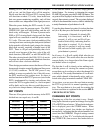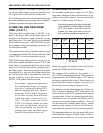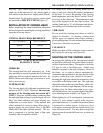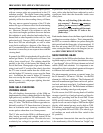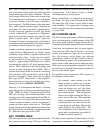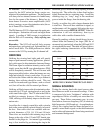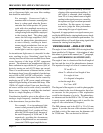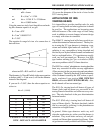
IRIS MODEL P522 APPLICATION MANUAL
Page 19
ing head male receptacle has an internal tab that
grounds this connection to the viewing head housing.
The terminal marked GND connects to the chassis
ground of the P522. This ground is made through the
etch on the rear side of the PC board to the metal base.
It is important that the AC power be a grounded
source (i.e., GND going to plant ground – refer to
section POWER SUPPLY). Interference problems
can occur if the power supply chassis and the P522
chassis are at a different ground potential than the
viewing head housing, which will be at a ground
potential associated with the burner front. In these
situations, the IRIS flame monitor effectively sup-
plies a plant ground between the burner front and
the panel enclosure. If there is a large potential dif-
ference between these points, considerable current
can flow through the viewing head cable, which can,
in turn, damage the P522 signal processor or the as-
sociated power supply.
If there is a voltage difference between the viewing
head and the sight pipe, then you should use a non-
conductive, one-inch plastic nipple between the sight
pipe and the viewing head mounting flange. This
voltage difference can be easily measured by dis-
connecting the viewing head from the mounting
flange so that there is no continuity between the view-
ing head and the boiler front.
Note: Use a battery operated multimeter
on a high voltage AC range for making
this measurement.
This measurement should be made under various
conditions (i.e., during the sequencing of the igniter
and burner).
In addition to using the isolated nipple for the view-
ing head flange, you must use a nonconductive rub-
ber or plastic hose for the purge air (there is a 1/2-
inch NPT pipe thread on the flange). This will pre-
vent the current from flowing through the IRIS cable
(power ground) back to the P522.
Another source of interference is from high-voltage
spark igniters. A high voltage of 6 KV or more is
usually supplied by a step-up autotransformer and,
not being isolated from the power line, it can cause
interference, particularly if there are grounding prob-
lems. The usual problem occurs when the trans-
former is energized, resulting in a bogus flame sig-
nal. The problem is not caused by the spark across
the gap, but by radiation from the high-voltage wir-
ing feeding the spark gap. It is the secondary wiring
of the transformer (high-voltage AC) that causes this
interference – both the insulated wire to the spark
gap, as well as the ground return. This circuit loop
acts like a giant antenna. Also, this type of trans-
former can cause a ground problem because it is an
autotransformer, and because it is not isolated from
the power line. The high-voltage current to the ig-
niter must return to the transformer through the plant
ground, which is the conductive metal of the plant.
The solution to these problems is to locate the igni-
tion transformer as close as possible to the igniter,
and away from the P522 and power supply. The
shorter the secondary wire run, the better. Also, the
ground return path should be examined. Is the ig-
niter properly grounded, and is this a good plant
ground? Plus, you should examine the grounding of
the transformer case: we recommend that there be a
good plant ground on the transformer case, and that
the transformer be enclosed in a metal enclosure that
is also grounded.
Usually, there are no straightforward solutions to
electrical interference problems; each will have its
own unique causes. However, there are certain pre-
cautions or guidelines that you should be aware of.
The first thing to check is the grounding of the in-
stallation. Make sure the AC power feeding the sys-
tem is grounded, and that the ground is a bona fide
plant ground. And, make sure the proper cable is
being used for the viewing head.
Note: Do not use cables that employ foil
type shields (aluminum-polyester). We
recommend you use the standard IRIS
cable that has a braided shield.
S506 VIEWING HEAD
The S506 viewing head employs a UV tube that has
a spectral response of 185-260nm. It is an inherent
pulsing device (i.e., the power supply has been de-
signed so that the tube emits pulses when UV radia-



